Showcasing Green Infrastructure Innovation Series on Vancouver Island launched in Nanaimo

First of three events shows there is an appetite for networking and sharing of lessons learned
The projected growth of Vancouver Island and resulting cumulative impacts are drivers for reassessing where and how land is developed, and water is used. To promote a new way-of-thinking related to infrastructure policies and practices, CAVI-Convening for Action on Vancouver Island has organized Showcasing Green Infrastructure Innovation on Vancouver Island: The 2007 Series.
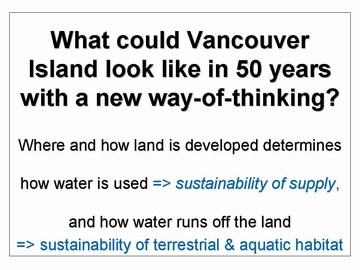
 According to John Finnie, CAVI Chair, “There are a lot of good things happening throughout Vancouver Island. Yet practitioners in local government are not necessarily aware when they are being innovative and are not often aware of innovation in other municipalities. Because people are so busy in their own worlds, it takes a third party to connect them. That is the role that CAVI plays.”
According to John Finnie, CAVI Chair, “There are a lot of good things happening throughout Vancouver Island. Yet practitioners in local government are not necessarily aware when they are being innovative and are not often aware of innovation in other municipalities. Because people are so busy in their own worlds, it takes a third party to connect them. That is the role that CAVI plays.”
Showcasing Innovation in Nanaimo
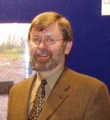 The first event in the series of three was co-hosted by the Regional District of Nanaimo and the City of Nanaimo on September 14. “The Showcasing Innovation Series creates pride and enables local governments to tell their stories in a way that no other forum currently provides,” observes Kim Stephens, Series organizer and event Moderator, and Program Coordinator for the Water Sustainability Action Plan for British Columbia.
The first event in the series of three was co-hosted by the Regional District of Nanaimo and the City of Nanaimo on September 14. “The Showcasing Innovation Series creates pride and enables local governments to tell their stories in a way that no other forum currently provides,” observes Kim Stephens, Series organizer and event Moderator, and Program Coordinator for the Water Sustainability Action Plan for British Columbia.
“CAVI is a regional pilot program that is being implemented under the umbrella of the Water Sustainability Action Plan,” adds Stephens.
Over 50 people from far and wide registered for the Nanaimo event. The diverse audience was comprised of representatives from four regional districts, ten municipalities, three provincial ministries, and a half-dozen private sector organizations. Included in the audience were elected representatives, senior managers, and on-the-ground practitioners.
Regional District Context
 In his welcoming remarks, Joe Stanhope, Chair of the Regional District of Nanaimo, provided context for the day when he described how he has applied design with nature principles to achieve a water and energy saving home. “On a personal note, my house could very well have been included on the tour today because it demonstrates what CAVI is about. It costs me only $10 per year to heat my house.”
In his welcoming remarks, Joe Stanhope, Chair of the Regional District of Nanaimo, provided context for the day when he described how he has applied design with nature principles to achieve a water and energy saving home. “On a personal note, my house could very well have been included on the tour today because it demonstrates what CAVI is about. It costs me only $10 per year to heat my house.”
“In the Regional District of Nanaimo, the elected representatives are providing direction through the Regional Growth Strategy. Our actions show that the Board members believe in sustainability,” Stanhope added, “Through the Urban Containment Boundary, we have avoided urban sprawl and we are doing our best to do what is right; and that is why the RDN Board is both supporting and partnering with CAVI. As a Board, we believe it is our job to protect the quality of life values that attract people to Vancouver Island.”
Report from the CAVI Chair
John Finnie followed Joe Stanhope and provided an overview of what has been accomplished by CAVI in Year One of a 3-year program. “The CAVI Leadership Team is really pleased and somewhat surprised at how successful and how quickly CAVI has advanced in the first year. Today we are at a point where we thought we might be in two or three years from now.”
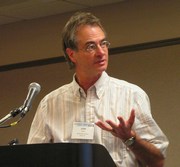 “CAVI had its roots in the Meeting of the Minds initiative which Eric Bonham spearheaded and got off the ground through his passion and energy,” noted Finnie, “Originally envisioned as a forum for water and wastewater practitioners to network, Meeting of the Minds has morphed into something bigger as CAVI.”
“CAVI had its roots in the Meeting of the Minds initiative which Eric Bonham spearheaded and got off the ground through his passion and energy,” noted Finnie, “Originally envisioned as a forum for water and wastewater practitioners to network, Meeting of the Minds has morphed into something bigger as CAVI.”
Finnie continued: “The CAVI vision for Vancouver Island is catching on. There is increasing interest. The turnout today is an indicator of the interest. We had a wait list for seats on the bus.”
“We believe a key to the success of CAVI is that we are talking to people, not preaching at them,” stated Finnie, “Our approach is to inform and educate. We do this by creating situations for people to have conversations. Like today.”
“The CAVI role is to plant seeds and start the conversations that will lead to action,” concluded Finnie, “We are encouraging people to move from conversations to dialogue, and to learn from the experience of each other.”
The Showcasing Series
The Showcasing Innovation Series comprises three one-day events in each of three regional districts, namely:
- Regional District of Nanaimo (September 14)
- Cowichan Valley Regional District (September 28)
- Comox-Strathcona Regional District (October 5)
Each event is co-hosted by the regional district and a member municipality. Each event comprises presentations in the morning and a tour of project sites in the afternoon.
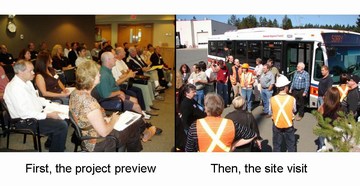
“Experience shows that the site tour creates those unplanned moments for spontaneous  and effective sharing of knowledge and lessons learned,” observes Kim Stephens, “We also find that the presentations in the morning serve to whet the appetite of the audience, and people then seek out the one-on-one opportunities to have a conversation on the bus. It is then that the real learning takes place.”
and effective sharing of knowledge and lessons learned,” observes Kim Stephens, “We also find that the presentations in the morning serve to whet the appetite of the audience, and people then seek out the one-on-one opportunities to have a conversation on the bus. It is then that the real learning takes place.”
The goal in showcasing innovation and celebrating successes is to promote networking, build regional capacity, and move ‘from awareness to action’ – through sharing of green infrastructure approaches, tools, experiences and lessons learned as an outcome of designing with nature.
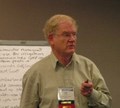 “Celebrating successes raises the bar and creates a healthy competition that will be self-fulfilling in achieving replication of design with nature outcomes,” adds Eric Bonham, Chair of the Highlands Stewardship Foundation and a founding member of CAVI. Bonham also notes that the Series is an effective way to promote region-wide networking and sharing of lessons learned.
“Celebrating successes raises the bar and creates a healthy competition that will be self-fulfilling in achieving replication of design with nature outcomes,” adds Eric Bonham, Chair of the Highlands Stewardship Foundation and a founding member of CAVI. Bonham also notes that the Series is an effective way to promote region-wide networking and sharing of lessons learned.
The Nanaimo Program
Consistent with the theme of ‘designing with nature’, a 6–person City of Nanaimo team led by Rob Lawrence (the City’s Environmental Planner) presented three case studies that illustrated Lessons Learned from Piloting Innovation in the City of Nanaimo.
- Case Study 1 – Oliver Road Community Centre: A LEED Silver Green Building
- Case Study 2 – Rainwater Capture at ‘Inland Kenworth’ Industrial Site
- Case Study 3 – Cottle Creek Estates: First Application of Steep Slope Policy
“We describe the approach to program design for the Showcasing Innovation Series as 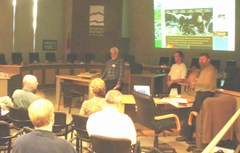 structured flexibility,” comments Kim Stephens, “While there is a framework and a desired outcome, we emphasize storytelling to encourage conversations within the presentations. People learn best from stories; and when someone tells a story, one never knows where the conversation may lead.”
structured flexibility,” comments Kim Stephens, “While there is a framework and a desired outcome, we emphasize storytelling to encourage conversations within the presentations. People learn best from stories; and when someone tells a story, one never knows where the conversation may lead.”
Setting the Context
Rob Lawrence set the context and introduced the unifying themes for the three  City presentations. “Our participation in the Showcasing Innovation Series has served as a catalyst for the City to evaluate our progress to date, and reflect on lessons learned from our experience in piloting innovation,” reports Lawrence.
City presentations. “Our participation in the Showcasing Innovation Series has served as a catalyst for the City to evaluate our progress to date, and reflect on lessons learned from our experience in piloting innovation,” reports Lawrence.
In his presentation, he identified four tools that are enabling City staff to drive green infrastructure innovation in Nanaimo:
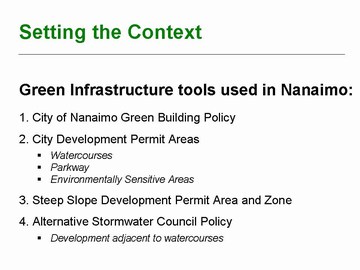
Rob Lawrence also elaborated on what is involved in finding the right `balance` to make things happen on the ground. His introductory comments foreshadowed one of the unifying themes for the three Nanaimo presentations, and that is: “It`s all about people, and most of all, it`s about involving the right people at the start. The ingredients for success include passion and a willingness to take a vision and make it happen.“
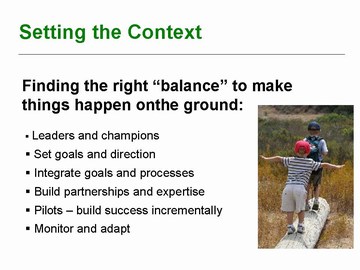
Case Study 1 – Oliver Road Community Centre:
The Oliver Road Community Centre is the first public building to be designed and built to a LEED Silver standard. Rob Lawrence and Maurice Mauch co-presented in order to provide the Green Building Council Policy and Oliver Road Community Centre project implementation perspectives, respectively.
To download a copy of their PowerPoint presentation, please click on this link to Green Building Policy and Oliver Road Community Centre . For more on the presentation by Rob and Maurice, please click here.
Case Study 2 – Inland Kenworth:
From a City of Nanaimo perspective, the Inland Kenworth industrial development is a milestone project because it represents the turning of the tide in the way land is being developed in the City. Furthermore, the raised expectations have changed the nature of consulting in Nanaimo by stimulating green infrastructure innovation. Gary Noble and Dean Mousseau co-presented in order to provide the planning and development services perspectives, respectively, as to how the Nanaimo Parkway Design Guidelines provided the catalyst for designing with nature.
To download a copy of their PowerPoint presentation, please click on this link to Inland Kenworth Site – Northfield Road. For more on the presentation by Gary and Dean, please click here.
Case Study 3 – Cottle Creek Estates:
The Cottle Creek Estates development is also a milestone project because it demonstrates what can be achieved by applying a design with nature way-of-thinking, both in terms of subdivision development and stream habitat creation. Deborah Jensen and Kevin Brydges co-presented to describe this first application of the bylaws that created Steep Slope Zones and the Steep Slope Development Permit Area Guidelines .
To download a copy of their PowerPoint presentation, please click on this link to Cottle Creek Estates on Hammond Bay Road . For more on the presentation by Deborah and Kevin, please click here.
Climate Change Community Action Plans:
In 2002, the Regional District of Nanaimo joined the Partners for Climate Change Program to reduce corporate energy use and greenhouse gas emissions. From a plan development perspective, the Nanaimo region has established a precedent in the way in which five individual municipal Community Action Plans dovetail with an overall regional plan.
Posted September 2007


